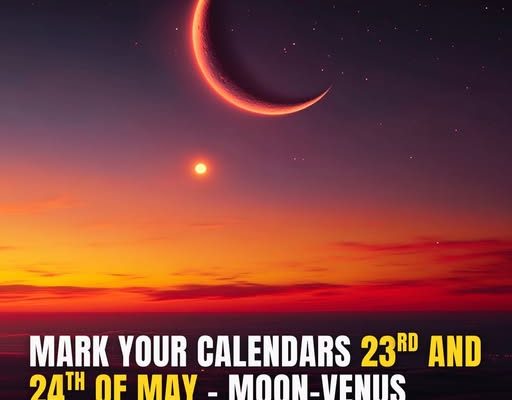It is worth setting your alarm clock to get you up approximately ninety minutes before sunrise if the local weather prediction indicates that Friday morning, the start of the Memorial Day Holiday Weekend, will be fair and clear. A beautiful combination of the two brightest objects in the night sky can be seen if you go outside at that early hour and have a clear, unhindered view towards the east.
The crescent moon will be visible right away; it will appear thin and silvery, with only 16 percent of its disc being lighted by sunlight. And Venus, a magnificent silvery-white celestial lantern of magnitude -4.5, will hover to the bottom left of the lunar crescent. The distance between the two items will be quite large—about 7 degrees, or almost three-quarters of the apparent width of your fist held at arm’s length.
Although these two objects won’t be coming very close together, their immense brightness makes them a striking sight in the early morning sky.What we are witnessing is, of course, a perspective illusion. Venus is 259 times farther away from Earth on this morning at 58.5 million miles (94.1 million km), whereas the moon is 225,700 miles (363,300 km). On June 1, Venus will reach its maximum western elongation, or its maximum angular separation from the sun. However, throughout the first half of the summer, it will gradually rise in the eastern morning sky. By the third week of July, it will have risen to three hours ahead of the sun, up from little under two hours now.

And for several more mornings, Venus will radiate with almost the same intensity.
Right now, at 3:35 a.m. local daylight time, Venus rises in the east. At that moment, morning begins, and the spooky, low glimmering of Venus is a sign of it. Venus’s illuminated area has grown to 45% in a telescope, making it nearly half full.
Once you are aware of Venus’s position in relation to the moon, try to monitor it after the sun has risen. You should have no issue glimpsing it in the daytime; a small white speck against the blue sky.
And Saturn too!
By the way, on Friday, while you’re looking at the moon and Venus, stop and look for Saturn. About 10 degrees (“one fist”) to the right of the crescent moon, you can easily see it gleaming complacently.
As you may remember, on April 25th, there was a lot of excitement over a new configuration between the moon, Venus, and Saturn. It was said to look like a happy face in the morning sky. However, many overlooked the fact that all three objects would be deeply ingrained in the bright early twilight and very low in the eastern sky.
Venus’s immense brightness made it easy for those who rose up early that morning to see it, but it was slightly harder to perceive the smile that the crescent moon, which was only 9% lighted, formed. However, you might not have been able to see Saturn unless you had binoculars because the incoming sunrise’s increasing light probably overshadowed it.
On Friday morning, though, you’ll have another opportunity to see all three items, and it will be lot simpler. For starters, the eastern sky will be darker, making all three appear taller and rising earlier. Compared to last month, the lunar crescent will be 7% wider, and Saturn should be easily visible with the naked eye.
Remember that it is only 1/191 as brilliant as Venus, so it will appear considerably dimmer. It is nearly the faintest Saturn has been seen, shining at magnitude +1.2. Its nearly edge-on rings will contribute virtually no light, which is the reason. However, you shouldn’t have any trouble seeing Saturn’s calm yellow-white glow against the early morning light.
A beautiful way to begin the unofficial summer season.
This summer, do you want to go out and look at the night sky? You can locate the equipment you require by using our guides to the top telescope and binoculars offers available right now.
You can also get ready to take pictures of the next skywatching event by following our guides to the best astrophotography cameras and lenses.
Joe Rao teaches and gives guest lectures at the Hayden Planetarium in New York. He contributes articles on astronomy to Sky and Telescope, Natural History magazine, and other magazines.

